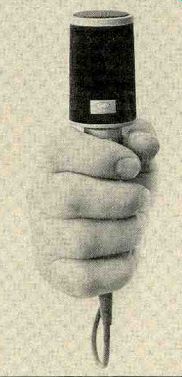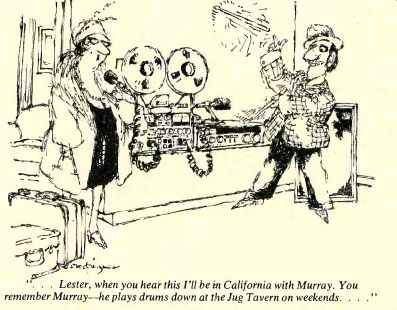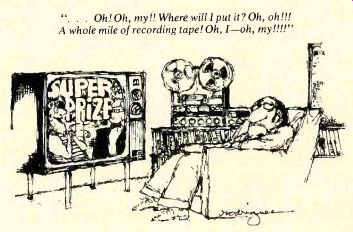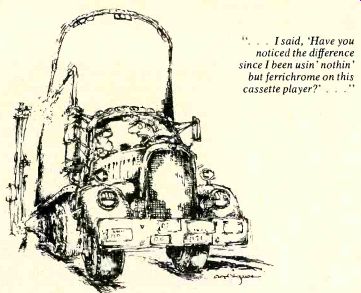
TAPE RECORDING-- JOHN WORAM.
A professional shares a few of his tips on how to do it right.
Anyone who has gotten even slightly involved in live recording very quickly comes up with a list of questions the how-to books and audiophile friends can't seem to answer. Trial and error will ultimately provide the solutions to most of the problems, but only at the expense of far too many bad takes, wasted sessions, and maybe even some inappropriate but costly equipment. Why do your recordings sound so echoey? Or dull? Or distorted? How can you get the proper mix between voices and instruments? In short, what are you doing wrong and how do you go about doing it right? I recently brought John Woram, a well-known recording engineer and consultant, together with a small group of amateur recordists for a question-and-answer session, and his notes were the basis for the question-and-answer exchange that follows. Certainly you won't find all your problems solved here (everyone has at least one unique question), but you may be surprised to learn how many of them are common to most be ginners-particularly the very first one.
-Larry Klein
----------
Q. How much should I expect a good recording setup to cost?
A. That depends on the type of re cording you intend to do. For example, if you plan to tape the church choir or organ, you'll need only a basic stereo recorder, two microphones, and a pair of headphones that can be driven by the recorder output. Anything more than that may just confuse the issue.
Make some test recordings with the microphones at various locations, listen to the playback over the headphones, make a decision about the best micro phone-to-sound-source working distance, and you're ready for your first take.
A simple stereo setup such as this puts very little strain on your budget, and with a little practice it will produce excellent to superb recordings. On the other hand, if you plan to record a rock group so that it sounds like a modern studio production, you'll need some thing more elaborate. At a minimum, you'll probably want a four-channel recorder, a small mixing console, ear phones for each member of the group, a number of microphones, and some sort of monitoring system.
At stores specializing in semiprofessional recording systems you'll find ba sic, "just getting started," no-frills set ups for about $2,500, assuming you have at least some stereo playback equipment on hand already. But, since it's not unusual for a serious recordist to invest many more times this amount as time goes on, as his system grows in size and complexity, I'd have to say that an "adequate" recording system can cost anywhere from less than $1,000 to more than $20,000. Of course, you can go much higher than that too.
Q. Won't headphone playback monitoring be somewhat misleading as compared to the usual control-room type of setup using loudspeakers?
A. Yes, but given the acoustic environment of churches and other large areas, the sound from loudspeakers may also be misleading. During playback between takes you will hear the room's "ambiance" doubled once as it was recorded and again as the recording is being played back within the same room. Of course it would be fine if you could set up a near by control room with loudspeakers, but in a typical case this may not be practicable. It may be easier to make a number of test recordings during on-location rehearsals, listen to the results in familiar surroundings while comparing them with your notes as to mike locations, etc., and then, having decided what sounded best, return for the actual recording session.
Q. If you're recording at an actual concert, how do you eliminate audience noises?
A. Unfortunately, you can't. Human perversity is almost sure to cause the chronic coughers to seat them selves as close to your microphones as they can get. And normally well behaved babies, if present, are simply bound to scream during quieter pas sages, maybe from having just been terrified by a fortissimo. To avoid all this, you can try to get the cooperation of the group you are Recording: they may agree that a pre- or post-concert performance without audience is worth the extra trouble.
Q. What kind of microphones should I buy?
A. For a basic two-microphone stereo setup, your best bet is probably a pair of uni-directionals. These are usually known as "cardioids" because of the characteristic heart shape of their polar patterns-the graph of their directional sensitivity.
A stereo pair of cardioid mikes are often placed quite close to each other but angled apart about 90 degrees.
Since the unidirectional mike is most sensitive to sounds originating directly in front of it, each mike favors one side of the ensemble, and a good stereo image is therefore recorded. In the case of large orchestral and/or choral groups, a carefully placed stereo pick up conveys an excellent impression of the breadth and depth of the ensemble as well as the acoustical ambiance of the room in which they are playing.
Q. If it takes so few mikes to make a good recording, why do so many of the pros set up a regular "forest" of microphones?
A The simple two-microphone arrangement demands ideal conditions-perfect ensemble balance and excellent room acoustics. But recordings are made in the real world; ideal conditions are usually found only in magazine articles. An extra mike or two may therefore be required here and there to help bring out a section which might not otherwise get picked up on the recording. Again, maybe the acoustics of the room are less than perfect, in which case it might be preferable to put up several extra close-up mikes to pick up more of the ensemble and less of the room sound.
But, as you can see, it's very easy to wind up with an "extra" mike on just about everything. This gives the engineer lots of control over the eventual total balance, but it sacrifices stereo perspective in the process. As a general rule, it's wiser to keep your extra microphones in their boxes, using them as sparingly as possible. An obvious exception, of course, is in recording rock, where it is customary to use one or more microphones on each instrument.
The reason is that stereo perspective is not nearly as important as being able to experiment, in the final mix, with different balances and signal-processing techniques. But before you commit yourself to a dozen or so microphones on, say, the drums, be sure you know what you are sacrificing in terms of "real" sound.
Q. Are there any special rules for buying mikes that are to be used for rock recording?
A. Since the "proper" microphone for anything is almost entirely a matter of personal taste even among professionals, it's best that you do a little experimenting with different types before you buy. More often than not, once you've established rapport, a reputable dealer will let you try out various mikes before you make your final decision. Have confidence in your own ears; if you like the way a certain mike sounds on the electric guitar, that's reason enough for using it.
There are a few basics to keep in mind while you are doing your experiments, however. For example, the cardioid microphone is most sensitive to sounds coming from directly in front, and that seems to make it a good choice if you wish to focus on just one instrument within a group. But most inexpensive cardioid mikes have other characteristics that may rule them out even for that: the "proximity effect" causes low-frequency response to rise as the mike is moved closer to the instrument, and "off-axis coloration" is another hazard-sounds from surrounding areas are picked up with (at times) severely distorted frequency response. A cardioid mike that is perfectly satisfactory in other respects may nonetheless give you too much bass when it gets too close and too much off-axis coloration when it is backed off. You may get better results with an omnidirectional mike which has neither of these weak nesses. As I said, experiment.
Q. When the microphone is very close N-4. to a loud instrument won't its out put be distorted in any case? A Not if it's a dynamic moving-coil r-t microphone. The distortion you hear will be the result of overloading the console (or tape recorder) input with the mike's high-level signal. The microphone itself is capable of with standing an incredibly high sound-pres sure level-much higher than the out put of any musical instrument. A con denser microphone, however, has a preamplifier built right into it, and this can possibly be overloaded by very high signal levels. Some condenser mikes have a switchable attenuator pad within to handle such levels, but if yours doesn't you'll have to back off a bit or choose a different microphone.
Q. Is there a "correct" way to set up a recording area before the musicians arrive?
A The best rule is to follow your own musical instincts. In most cases, there is no point in separating the musicians widely to keep the sound of one instrument from "leaking" into a microphone that is meant for another. If the distance is great enough to prevent such "leaks," it is also probably great enough to keep them from playing properly together-remember that proximity is an important factor in ensemble playing. In any case, you are better off moving your mikes in closer to the musicians than moving the players away from each other.
If you are using a pair of micro phones for an "overall" coverage of the sound, make sure that the outputs of any extra close-up mikes are not handled in the mixer in such a way that they conflict with the seating plan. Otherwise, the overall mikes will be telling you that the guitar, say, is somewhat left of center while the guitar's own mike is panned way off to the right; the conflicting directional information will blur the clarity of the whole recording.
Also remember that more-distant mikes will hear the program a bit later TAPE RECORDING...
(and with a more "echoey" quality) than the close-up ones do; if there are appreciable differences in distance, the combined outputs of the close-up and overall mikes may work to confuse or destroy the sense of space. Thus your mikes may have to be moved about quite a bit before and even during the session, and you should remember this when making your initial equipment setup. When you run your cables be tween mixer and mikes, plug the cable into the mixer first, then string it out gently to the mike. That way the slack, if there is any, is near the mike stand and available for moving with a mini mum of tangle.
Q. What sort of mixer should I get?
A. For a simple two-track stereo recording, none at all. Just plug the microphones directly into the tape recorder and you're ready to go. As soon as you start using more than one mike per recorded track, however, you are going to need a mixer to plug them into.
Depending on your requirements (and your budget), you can spend anywhere from $100 to $100,000 (!) on a mixer.
Some engineers consider the $1,000 level the "crossover point"-units be low that are "mixers" and above it they are "consoles." An appropriate mixer or console should enable you to route the outputs of several micro-phones to any track (or tracks) on your tape recorder. For example, if you've just finished recording two guitars on track 1 and a piano on track 2, you may now flip a few switches and route one of the guitar microphones to track 3, the other guitar and the piano to track 4--and that, of course, is the beginning of "creative mixing." How do the musicians get to hear
.these previously recorded tracks so they can play along with them? A The musicians listen over head phones to whatever was recorded previously. If the material is on just one track, it may be possible simply to plug the phones into the headphone jack on the tape recorder and monitor the output of the track already record ed along with the input of the track being recorded. (It may be necessary to install a low-power amplifier between the recorder [or mixer] and headphones to provide enough signal to drive sever-al sets of phones.) Thus the musicians hear both the old material and the new over their headphones.
A more flexible headphone monitoring system (it is often called "fold-back" or "cue") is built into some con soles-the console itself regulates the headphone feed. A separate set of controls permits the engineer to mix the previously recorded program with the new material for headphone listening while the new material is simultaneously being recorded on previously unused tracks.
If your mixer lacks this facility most of the inexpensive ones do-an alternative arrangement is often possible. Just route the previously recorded tracks to one or more of the mixer's line inputs. Then assign the related "faders" to one of the tracks that have already been recorded. Since you won't be pushing the record button for this track, the mix will not be record ed-but it can be routed to the head phone system to give the musicians a balanced combination of new and old material.
When there are several tracks of previously recorded program in the head phones, the musicians often have trouble hearing what they are doing "live." You may therefore want to assign the new live material to the headphone mix as well as to the separate tracks on which you are recording it.
How do I keep the new material synchronized with what was recorded earlier?
A. Make sure your tape recorder has a track-synchronizing feature. Various companies label it differently Sel-Sync, Simul-Sync, Self-Sync, Sync-Trak, and so forth-but the principle is the same in every case: while recording new material on an unused track, the previously recorded tracks are listened to from their correspond ing gaps on the record head. As the musicians play along with what they hear, the "active" gap on the record head records the new material directly in line on the tape with the old, thereby preserving the synchronization. Later, when all the recording has been done, the tape is played back from the playback head in the usual manner.
Q. What do I do if I run out of tracks on my tape recorder before the group runs out of instruments or voices to be recorded?
A. With a bit of electronic juggling, you can record an endless succession of instruments, even on a four-channel recorder. When you've recorded three tracks' worth of information, rerecord them as a single mix on track 4. (Since the original three tracks are going to be erased immediately after, this transfer process may be done using the playback head, for all the information will be on one track and there is no need as yet to sync it with anything else.) Now you can record new material on tracks 2 and 3 while monitoring track 4 (it contains the mix of the old tracks 1, 2, and 3) in the sync mode. If you like, you can then mix new tracks 2 and 3 with track 4 and feed everything via the playback head to track 1, which will information-and you are again left with three tracks to record on. You can keep doing this for as long as you can stand it-but remember that you will be accumulating more tape hiss with each transfer.
In a perhaps more likely situation, you may find you need just one or two more tracks than are available on the recorder. Let's say, for example, that the first three tracks have been record ed on your four-channel machine and you need two more. Mix tracks 1 and 2 together and record them on track 4, this time using the sync facility so the mix will remain in sync with track 3.
Tracks 1 and 2 may now be reused for a total of five recorded tracks.
Aren't there any problems with bouncing tracks around in this fashion? Just two. First, remember that the A playback head may be used for the transfer only when all previously recorded tracks are intended to be reused. Also note that, when using the sync facility, it is usually not possible to transfer material onto an adjacent track: track 3 may be mixed with track 4 and recorded on track 1, but not on track 2. The reason for this limitation is the crosstalk within the head itself.
Track 3 "hears" a little of what is being recorded on track 2, and if track 3 is being simultaneously recorded on track 2, the crosstalk results in a feedback squeal which will make the transfer impossible.
In any case, a judicious mixture of the two techniques described should give you all the tracks you are likely to need.
Q. If record only one or two tracks at a time, do I need more than two channels of noise reduction?
A. Yes. You need one for each track ". on your tape recorder, plus two more if you wish to prepare two-track master tapes from your four- (or more) track original recordings. When multiple tracks have been recorded, each must be played back through its own noise-reduction channel before being mixed with the other tracks. And then, of course, two additional channels will be needed to process the mix as it goes onto the two-track machine. But, in any case, the multitrack tape may not be mixed together first and then fed to a single stereo noise-reduction system.
Therefore, although you may need only one or two noise-reduction channels as you assemble your multi-track tape a track or two at a time, you'll need a full complement later for playback or mix-down work.
Q. Is it necessary to build a studio to record in?
A. If you are recording choirs, orchestras, or marching bands, there's little point in building your own studio.
Your local church, school auditorium, or football field usually provides the best recording location for such groups.
Rock music, on the other hand, is more often than not recorded in a studio no bigger than most living rooms, and, if your neighbors don't object, there's no reason why you can't make excellent recordings in a living-room "studio." Since a major acoustic over haul will cost you a fortune, you're probably better off confining your re modeling to moving a few chairs out of the way.
Q. But won't such recording be disturbed by outside noises?
A. Probably not. With close miking, it is unlikely that any microphone will hear much except the instrument it's aimed at. Of course you'll have to pause now and then for fire engines, ambulances, and low-flying planes unless you want to work them into your aural composition. In any case, the in convenience is more than offset by avoiding the expense of actually building a studio.
Q. What about those signal-processing add-ons that give you reverb and so forth?
A. As your recording system grows, you will want to experiment with one or more of the many signal-processing devices available. It would take a couple of columns just to list and de scribe very briefly all the special effects that are possible, but the most popular devices are the compressors and ex panders (of the program's dynamic range), the equalizers, and the reverberation systems.
In the case of compressors, expanders, and equalizers, the signal to be processed is routed through the device, which is then adjusted to produce the desired effect. It is often wise to do your recording work first, however, and add the signal processing later when you mix the recorded tracks together to produce the master tape.
Then, if it turns out that the signal-processing effect is not working out the way you expected, you can make changes or eliminate it completely. On the other hand, if you add too much compression to the guitar while it is being recorded, it is just about impossible to remove that compression later. Of course, if that guitar was being record ed with several other instruments onto one track, any processing later on would affect all the instruments on that track, so if you want a compressed guitar, compression would have to be applied at the time of recording.
When applying reverberation to an instrument or group of instruments, the sound is first balanced as desired. In addition, those instruments that require reverberation are routed to the reverberation system, whose output is then combined with the total program to produce the desired proportion of direct and reverberant sound. Many re-
verb systems have two outputs, and these may be fed to the left and right to produce a more natural simulation of stereo. As with compression and other forms of signal processing, artificial reverberation is usually applied during mixdown, not during the live recording session.
Q. I've got at least ten more questions-what'll I do with them?
A. Write them down and send them to STEREO REVIEW. Larry Klein and Craig Stark will find good use for them in their columns.
----------------


-----cartoon: . . Oh! Oh, my!! Where will I put it? Oh, oh!!! A whole
mile of recording tape! Oh, I-oh, my!!!!"

--------- . I said, 'Have you noticed the difference since I been usin'
nothin' but ferrichrome on this cassette player?' . . .
---------------
Also see:
NOISE DILEMMA--Is it possible to have full dynamic range without noise? DANIEL QUEEN
EQUIPMENT TEST REPORTS--Hirsch -Houck Laboratory test results on the Sansui TU-9900 AMIFM stereo tuner, Yeaple Stereopillow "nearphones," Kenwood KR-9600 AMIFM stereo receiver, and JBL L166 speaker system, JULIAN D. HIRSCH